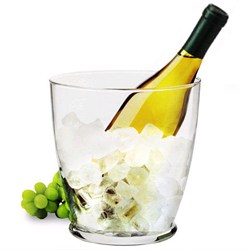In Part 1, we discussed the impact of temperature on red wines. We will now do the same for white wines. The effect of temperature is even more profound than it is for reds.
In general whites are stored in quite cool temperatures. My long-term whites like my long-term reds are stored at 14 degrees Celsius (57 degrees Fahrenheit). But then I have usually about 6 – 8 ‘ready-to-serve’ whites in my kitchen refrigerator which are stored at 2 degrees Celsius (36 degrees Fahrenheit). This is too cold a temperature to serve most white wines. In general, excellent white wines (Montrachets and other aged Chardonnays and Semillons) should be served at 10 – 14 degrees Celsius (50 – 57 degrees Fahrenheit) to really release their great flavors and bouquet. Typically good white wines (Most other Chardonnays, Rieslings, Pinot Grigios, etc.) served at 7 – 10 degrees Celsius (45 – 50 degrees Fahrenheit) and bad white wines as chilled as you like!
Boxed white wines and lower quality white wines are usually served very cold as they are lacking flavor anyway. What most ‘bad’ white wine drinkers are looking for a a refreshing, cool drink and lots of alcohol! But if you want to get the most flavor out of a white wine that it has to offer, then you should warm it up a few degrees.
In the past, I made the mistake of storing and serving my white wines too cold, especially if I took an excellent white wine directly from the fridge. Now I tend to take the wine out of the fridge for about 15 minutes to let it rise in temperature a few degrees and become more flavorful. This is often accomplished by putting the bottle in a carrying case to bring to a restaurant and the time it takes to get to the restaurant is perfect in terms of the wine being a few degrees warmer. Or if I am going to serve it at home, I let it sit on the counter for 15 minutes before serving it.
For an excellent white wine, especially a great and aged Chardonnay, I now let the wine warm up to about 12 degrees or so. (Note that I do not actually take the temperature of the wine, but rather just feel the bottle and compare the bottle to room temperature.) A bottle such as a great Montrachet or the Penfolds Yatarnna deserve this type of treatment and you will definitely notice the improved bouquet of wine in your nose and taste of the wine on your palate.
I love taking a sip when it is still ‘too cold’ and swirling an excellent white wine around my mouth. The body temperature of my mouth warms the wine almost immediately and over several minutes, you can pick up a variety of different tastes that keep changing over time. It is an amazing experience and worth savoring!
Champagnes and sparkling wines are usually served even more chilled than while wines. For low-end sparklings, you can serve them at 4 – 6 degrees Celsius, but good Champagnes should be served at a somewhat higher temperature.
- at 8°C, mineral and a little closed, perfect with an oyster tartare
- at 9°C, moderately open, to be matched with crayfish
- at 10°, complements wild salmon magnificently
- at 11°, chardonnay’s butter notes appear, volume amplifies
- at 12°, delicate mushroom aromas appear
- at 13°, pinot noir aromas, tannins! serve with a lamb tajine
- at 14°, smoky flavours and yoghurt aromas are revealed
- at 16°, aromas of meringue and walnuts, amazing intensity – magical with a tarte Tatin with candied violets
Most of us could not discern such differences in flavor, but some can. However, we can all learn from this and be appreciative of the difference a few degrees makes! BTW, if you want to do this experiment with a bottle at each degree between 8 and 16, it will cost you about $2,400 at $300 per bottle!
You deserve the enhanced flavor of letting a great white wine warm up a few degrees towards room temperature to enhance the taste. A number of people will take a great white wine directly out of their long-term cellar at 14 degrees Celsius (by now you should know this is 57 degrees Fahrenheit!) and serving it.
 |
| Right way – no ice |
If you have removed white wine from the fridge or a Vintec where it has been stored ‘cold,’ and once it has warmed up a couple of degrees to release the flavors, you should place the white wine in wine storage container without ice (like in the photo to the left). This ensures the wine stays at the right temperature for a long time (hopefully long enough to finish the bottle!). If you put it in an ice bucket, it will return the wine to close to freezing, choking off the flavor. Therefore, I never use ice in any manner with good white wine. (Or you may consider just using a few cubes to counterbalance the room temperature.) If you are drinking bad white wine, then use all the ice you want, as you want to hide the poor flavor!
 |
| Wrong! Do not use ice! |
We may not all have the discerning palate of Richard Geoffroy, but we can still greatly enhance our white wine tasting experience by making sure we are storing and serving the wine at the right temperatures.I have learned that there is great benefit in warming an excellent white wine up a few degrees before tasting it. Do some comparison testing and see if you do not agree!
And if this all seems just too hard, then for white wine, take it out of the fridge for 20 minutes before serving it and leave it at that. That is as good a rule of thumb as any.
